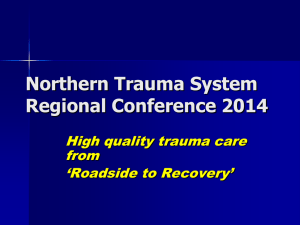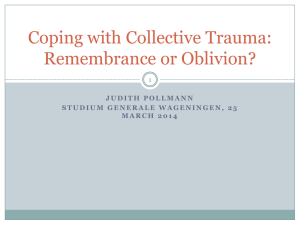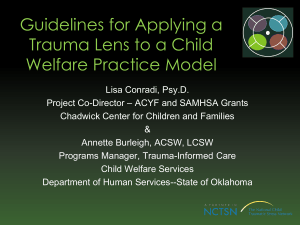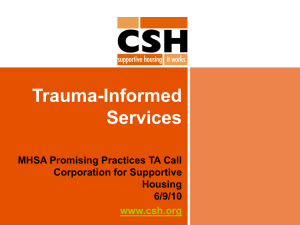Caring for Children Who Have Experienced Trauma: Module 3
advertisement
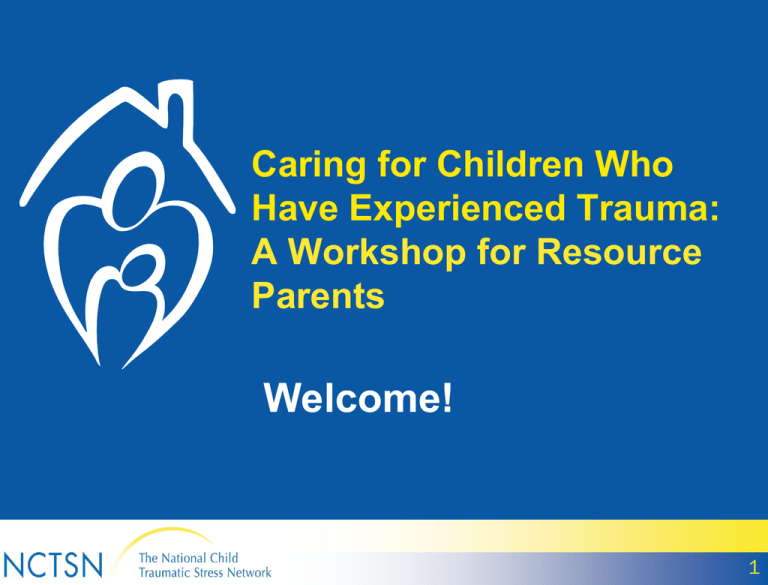
Caring for Children Who Have Experienced Trauma: A Workshop for Resource Parents Welcome! 1 Why a Trauma Workshop? Many children in foster care have lived through traumatic experiences. Children bring their traumas with them into our homes. Trauma affects a child’s behavior, feelings, relationships, and view of the world in profound ways. (Continued) 2 Why a Trauma Workshop? (Continued) Children’s trauma affects us, too: • Compassion fatigue • Painful memories • Secondary traumatization Trauma’s effects—on children and on us—can disrupt a placement. A Foster Dad Speaks No one really explained to me about the impact of trauma on a child’s life. I wish I’d known more about trauma sooner. —Sam, foster dad 4 Understanding Trauma’s Effects Illustrations by Erich Ippen, Jr. Used with permission. 5 We Learn by Experience (Continued) 6 We Learn by Experience (Continued) (Continued) 7 We Learn by Experience (Continued) 8 Your Internal Alarm System If the threat is removed, everything returns to normal The brain releases chemicals that help the body to respond to the threat (fight, flight, freeze) (Continued) 9 Your Internal Alarm System (Continued) If the threat continues or is repeated, the system stays on "red alert" The brain releases chemicals that help the body to respond to the threat (fight, flight, freeze) 10 Experience Grows the Brain Brain development happens from the bottom up: • From primitive (basic survival) • To more complex (rational thought, planning, abstract thinking) (Continued) 11 Experience Grows the Brain (Continued) The brain develops by forming connections. Interactions with caregivers are critical to brain development. The more an experience is repeated, the stronger the connections become. 12 Trauma Derails Development Exposure to trauma causes the brain to develop in a way that will help the child survive in a dangerous world: On constant alert for danger Quick to react to threats (fight, flight, freeze) The stress hormones produced during trauma also interfere with the development of higher brain functions. Source: Teicher., M. H. (2002). Scars that won't heal: The neurobiology of child abuse. Scientific American, 286 (3),68-75. 13 Young Children (0–5) Key Developmental Tasks Trauma’s Impact Development of visual and Sensitivity to noise auditory perception Recognition of and response to emotional cues Attachment to primary caregiver Avoidance of contact Heightened startle response Confusion about what’s dangerous and who to go to for protection Fear of being separated from familiar people/places (Continued) 14 School-Aged Children (6–12) Key Developmental Tasks Manage fears, anxieties, and aggression Sustain attention for learning and problem solving Control impulses and Trauma’s Impact Emotional swings Learning problems Specific anxieties and fears Attention seeking Reversion to younger behaviors manage physical responses to danger (Continued) 15 Adolescents (13–21) Key Developmental Tasks Think abstractly Anticipate and consider the consequences of behavior Accurately judge danger and safety Modify and control Trauma’s Impact Difficulty imagining or planning for the future Over- or underestimating danger Inappropriate aggression Reckless and/or self-destructive behaviors behavior to meet long-term goals 16 Getting Development Back on Track Traumatized children and adolescents can learn new ways of thinking, relating, and responding. Rational thought and self-awareness can help children override primitive brain responses. Unlearning—and rebuilding—takes time. (Continued) 17 What Trauma-Informed Parents Can Do Offer a secure base of love and protection. Be emotionally and physically available. Recognize and respond to the child’s needs. Provide guidance and example. Provide opportunities to safely explore the world. Source: Better Brains for Babies. (2007). Attachments and the role of the caregiver. Available at http://www.fcs.uga.edu/ext/bbb/attachCareGiver.php 18 The Invisible Suitcase Trauma shapes children’s beliefs and expectations: About themselves About the adults who care for them About the world in general 19 The Invisible Suitcase 20 Meet Maya (8 Months Old) Maya wakes up crying in the middle of the night. When her Aunt Jenna tries to soothe her, Maya arches her back, pushes her hands against Jenna’s shoulders, and screams even harder. When Jenna tries to make eye contact with Maya, the baby turns her head away. “This little baby makes me feel completely rejected,” Jenna says. “Sometimes I feel so helpless, I just have to put her down and let her cry.” 21 Maya’s Story Maya was taken into care after her 17-year-old mother brought her to the ER unconscious, with broken arms and bruises. Maya and her mother Angela had been living with her mother’s abusive boyfriend. For a brief time recently, Angela and Maya had lived in a shelter for victims of domestic violence. Angela claimed Maya was hurt while in the shelter. 22 Maya’s History Exposure to domestic violence Physical abuse, including broken bones and bruises Separation from her mother Medical trauma, including hospitalization 23 Maya’s Behaviors Cries and screams, rejects comfort Is easily startled and distressed by loud noises Screams when brought to the doctor’s office— even before a doctor or nurse has touched her Takes comfort from her bottle when it is propped up rather than when it is being held Is soothed by a particular piece of music 24 What’s in Maya’s Suitcase? (Group Activity) Beliefs about herself? Beliefs about her caregivers? Beliefs about the world? 25 What's in the Suitcase? (Group Activity) Take a plastic sandwich bag from the center of the table. Using separate slips of paper, write down what you think might be in your child’s “invisible suitcase.” Be sure to include: • Beliefs and expectations about him- or herself • Beliefs and expectations about you and other caregivers • Beliefs and expectations about the world 26 “Repacking” the Suitcase (Group Activity) How can we “repack” this suitcase with positive experiences and beliefs? How can we promote resilience in this child by making him or her feel: • Safe? • Capable? • Lovable? 27 The Essential Elements of Trauma-Informed Parenting* 1. Recognize the impact trauma has had on your child. (Continued) *Adapted from “The essential elements of trauma-informed child welfare practice” from the National Child Traumatic Stress Network’s Child Welfare Trauma Training Toolkit. 28 The Essential Elements of Trauma-Informed Parenting (Continued) 1. Recognize the impact trauma has had on your child. 2. Help your child to feel safe. (Continued) 29 The Essential Elements of Trauma-Informed Parenting (Continued) 1. Recognize the impact trauma has had on your child. 2. Help your child to feel safe. 3. Help your child to understand and manage overwhelming emotions. (Continued) 30 The Essential Elements of Trauma-Informed Parenting (Continued) 1. Recognize the impact trauma has had on your child. 2. Help your child to feel safe. 3. Help your child to understand and manage overwhelming emotions. 4. Help your child to understand and modify problem behaviors. (Continued) 31 The Essential Elements of Trauma-Informed Parenting (Continued) 1. Recognize the impact trauma has had on your child. 2. Help your child to feel safe. 3. Help your child to understand and manage overwhelming emotions. 4. Help your child to understand and modify problem behaviors. 5. Respect and support positive, stable, and enduring relationships in the life of your child. (Continued) 32 The Essential Elements of Trauma-Informed Parenting (Continued) 1. Recognize the impact trauma has had on your child. 2. Help your child to feel safe. 3. Help your child to understand and manage overwhelming emotions. 4. Help your child to understand and modify problem behaviors. 5. Respect and support positive, stable, and enduring relationships in the life of your child. 6. Help your child develop a strength-based understanding of his or her life story. 33 The Essential Elements of Trauma-Informed Parenting (Continued) 1. Recognize the impact trauma has had on your child. 2. Help your child to feel safe. 3. Help your child to understand and manage overwhelming emotions. 4. Help your child to understand and modify problem behaviors. 5. Respect and support positive, stable, and enduring relationships in the life of your child. 6. Help your child to develop a strength-based understanding of his or her life story. 7. Be an advocate for your child. (Continued) 34 The Essential Elements of Trauma-Informed Parenting (Continued) 1. Recognize the impact trauma has had on your child. 2. Help your child to feel safe. 3. Help your child to understand and manage overwhelming emotions. 4. Help your child to understand and modify problem behaviors. 5. Respect and support positive, stable, and enduring relationships in the life of your child. 6. Help your child to develop a strength-based understanding of his or her life story. 7. Be an advocate for your child. 8. Promote and support trauma-focused assessment and treatment for your child. (Continued) 35 The Essential Elements of Trauma-Informed Parenting (Continued) 1. Recognize the impact trauma has had on your child. 2. Help your child to feel safe. 3. Help your child to understand and manage overwhelming emotions. 4. Help your child to understand and modify problem behaviors. 5. Respect and support positive, stable, and enduring relationships in the life of your child. 6. Help your child to develop a strength-based understanding of his or her life story. 7. Be an advocate for your child. 8. Promote and support trauma-focused assessment and treatment for your child. 9. Take care of yourself. 36 The Essential Elements of Trauma-Informed Parenting (Continued) 1. Recognize the impact trauma has had on your child. 2. Help your child to feel safe. 3. Help your child to understand and manage overwhelming emotions. 4. Help your child to understand and modify problem behaviors. 5. Respect and support positive, stable, and enduring relationships in the life of your child. 6. Help your child to develop a strength-based understanding of his or her life story. 7. Be an advocate for your child. 8. Promote and support trauma-focused assessment and treatment for your child. 9. Take care of yourself. 37 What Trauma-Informed Parenting Can Do When we protect them from harm. . . . . . children learn that the world is safe. When we support, nurture, and respond to them. . . . . . children learn that they are capable. When we give them affection and love . . . . . . children learn that they are lovable. 38 Resource Parents Are . . . . . . like shuttles on a loom. They join the threads of the past with threads of the future and leave their own bright patterns as they go. —Fred Rogers Photograph of Fred Rogers used by permission of Family Communications, Inc. (www.fci.org). 39 Caring for Children Who Have Experienced Trauma: A Workshop for Resource Parents WWW.NCTSN.org 40






